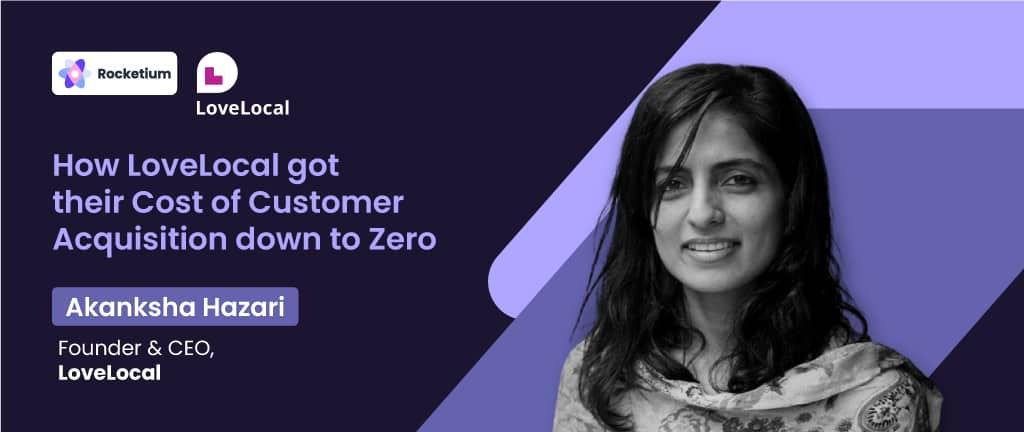Speaker Info

Akanksha Hazari
CEO,
LoveLocal
How LoveLocal got their Cost of Customer Acquisition down to Zero ?
Understanding how a Hyperlocal eCommerce marketplace like Lovelocal functions
Hyperlocal marketplace or as Akansha described it ‘retailer-first’ marketplace is an on-demand delivery model that helps end-users to connect with local retail shops near them.
This marketplace serves as an online platform to connect customers to their trusted neighborhood shops (grocery, chemists, pet shops, etc). On one end they have the customers delegating their daily chores more conveniently and on the other end, they have the local retailers who are getting an opportunity to scale their business.
LoveLocal has two sets of audiences to acquire: one, retailers, and two, consumers. Akansha Hazari, the Founder, and CEO of LoveLocal dives into how her team at LoveLocal prioritized acquiring local retailers to bring their customer acquisition cost to zero.
LoveLocal’s secret sauce for Zero CAC: Targeting Retailers
According to Akansha, retail businesses ‘Account for 40% of jobs in India directly’ and are considered a major growth driver for the economy. Therefore, creating a solution that helps them digitize and modernize their business can bridge the gap that exists in the technology part.
She believes that “By empowering local businesses that have already been providing the best solution in terms of delivery, product selection, etc. for many decades, we can deliver better for the end customers.” Fundamentally, following a ‘retailer first approach’ for business owners who already have a loyal customer base means bringing more customers on board.
At Lovelocal, the team has designed the business model in a way that brings in retailers acquired either through shop referrals or customer referrals. They focus not just on scaling the number of retailers but also the types of retailers available on their platform.
The thought behind it is that “Everyone is buying something or the other from local stores. Local retail accounts for 95% of shopping in India but less than 1% of Grocery is digitized.”
How this digital bandwagon for local retailers scaled acquisition and growth
Just before Covid, the world was already moving towards digitalization which created a growing base of retailers willing to come online. So when Lovelocal was launched, the platform saw much more demand than what the team had anticipated.
With the lockdown, the platform saw a massive jump in the number of retailers willing to onboard. So the team took a product-first approach to solve digital acquisition, onboarding, and management of stores end-to-end to acquire retailers from all over the country.
“In 24 months we went from 1 city to 35 cities and 1900 pin codes”
In order to achieve this, the LoveLocal team used both digital and non-digital channels to expand their business. The digital ways include Facebook and Google Advertising while the non-digital channels include door-to-door advertising. In their case, the major takeaway was that “Digital channels massively outperformed non-digital channels as online advertising attracted much more ‘pull users’ than ‘push users’.”
Non-digital platforms require salespeople to go market by market convincing retailers to onboard, but this technique fails as ‘No market can be in the same phase of digitization’ as there are both adopters and late adopters who are in different phases of digitization altogether. On the other hand ‘pull users’ coming from digital platforms are already savvy with technology and are actively looking for ways to go online.
Talking about customer acquisition and growth, Akansha quotes “80 to 90 percent of LoveLocal customers come from retailers”. Instead of just focusing on a retail-to-retail referral program, LoveLocal empowers its retailers with easy-to-use features and a lot of content so that they are constantly using the app to promote their online shop to their consumers.
What type of content works for LoveLocal?
In the case of LoveLocal, creatives with testimonials and stories of other retailers who have achieved success through the platform have worked wonders. This happens because retailers who are actively looking to move to online platforms relate to the stories and end up onboarding. These testimonials are so powerful that the team has included them in their training videos as well.
Akansha believes “In countries like India retailer communities are very tight which leads others to join as soon as one of them sees success. Hence, these retailers end up becoming the biggest promoter only if one owns their trust.”
Also, by declaring that they will never do anything to compete with local retail, they have built a certain level of trust among the local retailers. The team has turned a complete blind eye towards evenly organized retailers and micro fulfillments, encouraging more and more retailers to onboard.
Final Words
The key learning from the chat with Akansha is that the foundation of any business starts with the right acquisition. Spending money and targeting the wrong audience will ultimately acquire customers that don't fit with the business’ goal. Instead, focusing on solving the problem and finding users who care about the problem, this will have a stronger impact on the longevity of the business.
